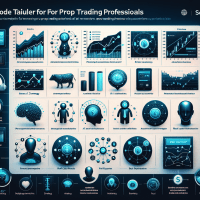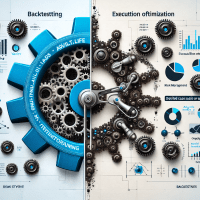Solvent.Life vs Vantir: AI Strategy vs Feedback Models in Prop Trading
In today’s dynamic prop trading landscape, the integration of AI-driven strategies and feedback models has become critical for sustainable success. Prop firms are increasingly leveraging advanced AI frameworks such as Solvent.Life and Vantir to optimize their trading approach, reduce risk, and enhance performance. This post delivers an in depth comparison of Solvent.Life’s AI strategy with Vantir’s AI feedback models, while diving into expert backtesting practices, detailed tool reviews, and actionable insights for traders and risk managers in the proprietary trading sector.
Understanding the Role of AI in Prop Trading
Prop trading firms are driven by the constant pursuit of optimizing performance while effectively navigating market volatility. AI strategies and real-time feedback models help propel firms by not only automating results but enhancing decision-making through dynamic data analysis. Both Solvent.Life and Vantir offer distinct solutions to meet these needs.
Why AI Strategy and Feedback Matter
The core differences between the two offerings reside in how they approach automated strategy development. Solvent.Life emphasizes a proactive AI strategy that analyzes historical data, builds predictive models, and automates parameter optimizations. In contrast, Vantir focuses on harnessing AI for real-time feedback, enabling continual adjustments to strategies as market conditions change. For prop firms, the ability to blend these approaches can result in a robust framework capable of mitigating risk and maximizing returns.
Advanced Backtesting: The Core of Prop Trading Success
An effective backtesting process is indispensable in prop trading. Whether deploying an AI strategy or monitoring live trading feedback, backtesting provides the historical performance insights necessary for refining models. This section explores advanced backtesting concepts that are crucial for quantifying risk and performance.
Common Pitfalls in Backtesting
Despite its importance, backtesting is riddled with pitfalls, including:
- Overfitting: Crafting a model that works perfectly on historical data but fails in the real market.
- Survivorship Bias: Using only the surviving entities from a historical dataset, leading to overly optimistic results.
- Look-Ahead Bias: Incorporating future data into the model improperly.
- Data Snooping: Frequent testing that increases the risk of false positives.
These issues require sophisticated mitigation strategies, such as walk-forward optimization and out-of-sample testing.
Walk-Forward Analysis vs. Traditional Backtesting
Walk-forward analysis is an iterative process that simulates real trading conditions more realistically than static backtesting. By adjusting parameters in a predefined timeframe and then testing them on a subsequent period, traders can validate the effectiveness of their strategies in a phased manner. Prop trading firms benefit from this method by aligning simulation with real-world market dynamics, enhancing model robustness.
Out-of-Sample Testing and Forward Testing
Alongside walk-forward optimization, out-of-sample testing ensures that strategies perform well in data not previously seen by the model. Forward testing, or paper trading, then bridges the gap between backtesting and live deployment, providing a safety net before committing real capital.
Comparing Automated Backtesting Tools for Prop Trading
Successful prop traders rely on robust tools for backtesting and strategy validation. Below is an in-depth comparison of three widely recognized platforms: TradingView, MetaTrader 5, and NinjaTrader.
| Feature | TradingView | MetaTrader 5 | NinjaTrader |
|---|---|---|---|
| Backtesting Approach | Vectorized backtesting with Pine Script; supports historical analysis. | Combination of event-driven and vectorized approaches with MQL5; robust commission and slippage simulation. | Primarily event-driven; offers detailed scenario and optimization reports. |
| Data Quality | Extensive charting data for multiple asset classes; relies on community data feeds. | High-quality historical data with tick-level resolution; covers forex, stocks, and futures. | Competitive historical data; strong integration with real-time feeds for futures and forex. |
| Integration & API | Limited API access; integrated with third-party analytics. | Full API integration with broker platforms; seamless data incorporation. | Advanced API and third-party plugins; supports automated trading and team collaboration. |
| Pricing & Tiers | Free basic version; premium plans from $14.95/month. | Free demo; live accounts vary by broker with wide pricing flexibility. | Free simulation; commercial licenses available for advanced functionalities. |
| Prop Firm Suitability | Best for individual retail traders; may require additional integration for team setups. | Highly scalable with built-in compliance and risk management tools ideal for prop firms. | Designed for both individuals and teams; collaboration features and regulatory compliance make it prop firm-friendly. |
These platforms illustrate varied approaches to backtesting, data quality, and integration capabilities. Prop trading firms should choose the tool that best aligns with their operational needs and regulatory requirements.
Case Study: Integrating AI Feedback in a Prop Trading Firm
Consider a mid-sized proprietary trading firm that recently transitioned to an AI-enhanced trading model. Facing challenges such as rapidly changing markets and suboptimal trade timing, the firm deployed a hybrid approach using Solvent.Life’s AI strategy combined with Vantir’s AI feedback mechanisms.
Challenges Faced
- Difficulty in identifying subtle market signals with static backtesting methods.
- Issues with fine-tuning parameters in response to real-time market fluctuations.
- Need for efficient report generation to reduce iteration times.
How AI Tools Addressed the Challenges
By leveraging Solvent.Life’s historical modeling, the firm was able to automate parameter optimization and run extensive in-sample tests. Concurrently, Vantir’s feedback systems provided continuous performance metrics during live paper trading sessions. The combination allowed for faster identification of overfitting and real-time adjustments that significantly improved the Sharpe ratio and reduced maximum drawdown.
Results:
- Sharpe Ratio improvement from 0.8 to 1.4 within 3 months.
- Maximum drawdown reduced by 25% via automated stop-loss adjustments.
- Iteration time for strategy refinements cut in half, leading to more agile trade management.
Practical Tips for Implementing AI Strategies in Prop Trading
To successfully implement these AI techniques, prop trading professionals should consider the following:
- Data Quality Is Key: Ensure that you are using high-quality, granular datasets. This might mean opting for tick data over bar data when using platforms like MetaTrader 5.
- Prioritize Walk-Forward Testing: Instead of solely relying on historical backtests, incorporate walk-forward and out-of-sample testing to ensure robustness.
- Integrate Automated Reporting: Tools like NinjaTrader offer sophisticated report generation that can highlight performance metrics such as profit factor and drawdown metrics automatically.
- Use Code Snippets for Automation: Integrate Python-based algorithms using libraries like Backtrader to automate routine tasks. For instance:
import backtrader as bt
class SMAStrategy(bt.Strategy):
params = (('period', 20), )
def __init__(self):
self.sma = bt.indicators.SimpleMovingAverage(self.data, period=self.p.period)
def next(self):
if self.data.close[0] > self.sma[0]:
self.buy()
elif self.data.close[0] < self.sma[0]:
self.sell()
cerebro = bt.Cerebro()
# Add data and strategy
cerebro.run()
Integrating Forward Testing and Transitioning to Live Trading
After robust backtesting, the next critical step for prop traders is forward testing using paper trading environments. This step is essential for understanding how the strategy performs under live market conditions. Always monitor key metrics such as the Sharpe ratio, profit factor, and maximum drawdown during these sessions.
Internal Links and Further Resources
For readers interested in deepening their expertise, consider exploring our detailed guide on Risk Management in Prop Trading and our analysis of Advanced Prop Trading Strategies. These resources delve into complementary aspects of effective trading practices.
Conclusion: Next Steps for Prop Trading Professionals
The evolution of AI in prop trading opens new frontiers for optimizing strategy and managing risk. The comparison between Solvent.Life’s AI strategy and Vantir’s real-time feedback models underlines the importance of harmonizing historical backtesting with dynamic, real-time adjustments. For prop trading professionals seeking to stay ahead in a competitive market, embracing these advanced methodologies is not just an option, but a necessity.
Pro Tip: Download our comprehensive Risk Management Checklist to ensure you are covering every aspect of your trading strategy—from data integrity to regulatory compliance. As of October 2023, leveraging these tools can significantly elevate your trading efficiency.
Implement these insights into your trading workflows and observe quantifiable improvements. Whether you are a junior trader looking to refine your approach or a senior quant managing a multi-faceted strategy portfolio, the key lies in integrating robust automated backtesting with consistent forward validation.
For further questions and continuous updates on prop trading strategies, subscribe to our newsletter and join our upcoming webinar on optimizing AI integrations in trading.







